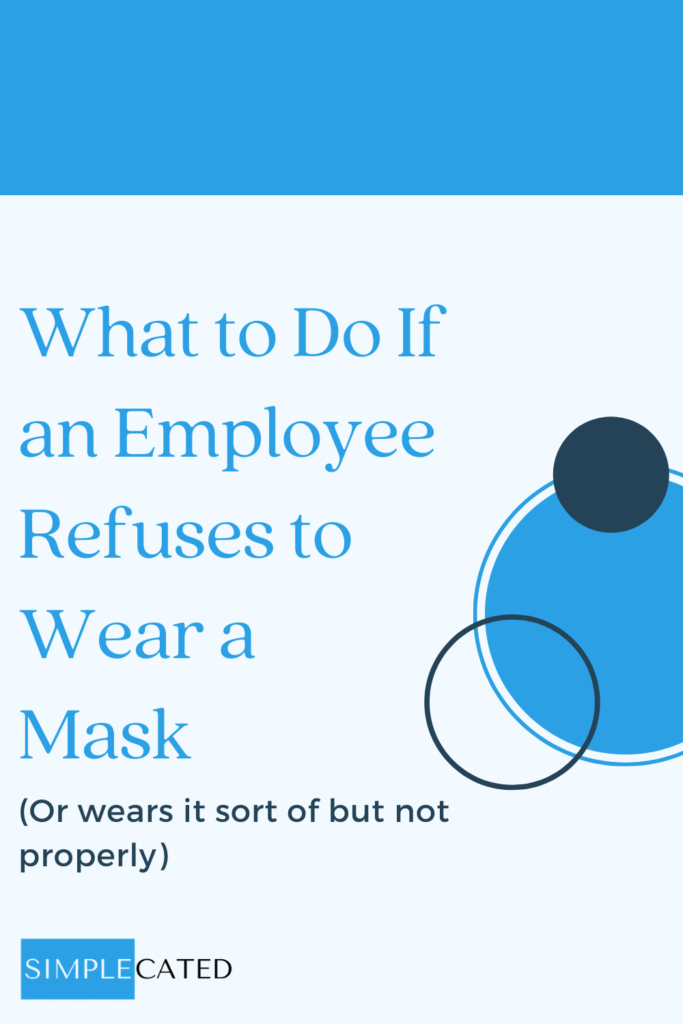As more and more businesses open their doors and employees return to the office, one of the most common questions is – will masks be required? In general, we’re getting used to the answer being “yes.” We’ve become more educated on the importance of them. Some states require masks, some businesses require them of employees and customers, and we’re seeing them worn as professional sports resume. Deciding to require masks may be a relatively easy decision, but then that raises a question you as a manager know you have to sort through from the beginning:
What do you do if an employee refuses to wear a mask? (Or wears it sort of but not properly?)
First, let’s back up a bit. Employers can require their employees to wear masks. The CDC recommends that everyone wear a face mask as protection during this COVID-19 pandemic, and OSHA (the Occupational Safety and Health Administration) recommends that employees wear them at work, along with practicing social distancing. Plus, it’s good for morale! Requiring face masks sends a message to employees that you care about their safety and may help alleviate concerns from employees about returning onsite to work. OSHA does outline, however, that cloth face coverings may not be appropriate in all jobs:
“For some workers, employers may determine that wearing cloth face coverings presents or exacerbates a hazard. For example, cloth face coverings could become contaminated with chemicals used in the work environment, causing workers to inhale the chemicals that collect on the face covering. Over the duration of a work shift, cloth face coverings might also become damp (from workers breathing) or collect infectious material from the work environment (e.g., droplets of other peoples’ infectious respiratory secretions).”
You’ll want to review your jobs to determine if a cloth face mask could be a hazard. If the cloth could get caught in machinery or become contaminated, you may need to provide other options. If cloth face coverings aren’t appropriate, OSHA recommends employers consider face shields and surgical masks. (On August 7, 2020, the CDC announced they don’t recommend face shields as a substitution, however, if someone needs a face shield instead, it should “wrap around the sides of the wearer’s face and extend below the chin” or be a hooded face shield.)
If you require cloth face masks, do you have to provide them to your employees? Some states require that you do, but otherwise, OSHA says you don’t. Since cloth face masks are intended to protect others, they aren’t considered personal protective equipment (PPE) and don’t have to be provided by the employer.
Let’s say you’ve decided to require masks (which I hope you do), what are your next steps?
- Review your jobs to determine if any of them need special kinds of masks. If cloth face coverings present a hazard, you’ll want to provide another kind of face covering. If your employees are customer-facing or interact with others who have hearing difficulties, it may be helpful for their mouths to be seen, so consider masks with clear panels.
- Determine whether you’ll be providing any masks. Even if you aren’t required to, it’s a nice gesture to provide masks to your employees. Although cloth face masks are sold just about everywhere now, consider providing a mask to each employee with your company logo or a fun design. I’d also have some extra masks available in case someone forgets a mask or it breaks or gets dirty. You don’t want your only option to be to send someone home. If any jobs need special kinds of masks, provide them.
- Communicate this new policy. Keep your communication light-hearted! If you’re having fun with this, it can help ease the stress of it all and give your employees a good perspective about it. After all, masks are the newest form of self-expression! Let your employees know they are required to wear masks at work that properly cover the nose and mouth. Explain why this is being required (including that it’s for their wellbeing), whether you’ll be providing any for them, and that leaders will work directly with any jobs that require special kinds of face coverings. Encourage them to get creative with their masks (abiding by your dress code also – such as no profanity, etc.), and have theme days or contests. Encourage employees to reach out with questions or concerns.
Back to our original question: What do you do if an employee refuses to wear a mask? (Or wears it sort of but not properly?)
Talk with the employee to understand the concern. There could be a legitimate concern, so you want to find out what’s going on. Listen to the employee, and keep in mind the overall goal of this policy – to create a safe environment that protects everyone’s wellbeing. If employees simply say they don’t want to wear masks, try to win them over. Mask-wearing has become so politicized that people sometimes react very emotionally about it, so try to keep the conversation even-keeled and focused on facts. Remind them why it’s important and that wearing a mask can help protect others and creates a positive environment. If they say it violates their rights, explain that’s inaccurate. Not only can employers require masks, but it’s encouraged by government agencies.
Consider ADA accommodation requests. If employees have health concerns (perhaps asthma or other conditions that cause breathing difficulties), work with them the same way you would any ADA accommodation request. There may be a really easy solution, such as allowing them to use a face shield, work separately from others, or work from home. (Remember to help your workers with hearing or speech difficulties as well. Even if they are able to wear regular masks, they may need others to wear masks with clear panels so they can better communicate. While not an ADA accommodation request, being empathetic helps creative a positive environment where everyone can succeed.)
Apply your discipline policy. You can issue discipline, including termination, for not wearing a mask. If employees simply refuse to wear masks with no legitimate reason, let them know your standard discipline policy applies to this, and proceed accordingly. The same is true for employees who refuse to wear masks properly; remind them of the expectation, and then apply the discipline policy if it continues. Not following the mask policy is essentially not following directions, potentially is insubordination, and could cause harm to others, so address it promptly. This isn’t something to play around with. If you allow this to continue, not only could it damage morale but this employee could end up infecting other people, and then you’ve got a big issue on your hands. You can even apply leadership lessons from how Tom Cruise handled COVID violations with his crew!
Employers can require employees to wear masks, and doing so can help slow the spread of COVID-19 and protect the wellbeing of employees. If you have an employee who refuses to wear a mask, find out if there is a legitimate concern that may require going a different route that still meets the same goal. Otherwise, explain the importance of it, and then address it promptly if it continues. You don’t need to keep an employee who can’t prioritize the wellbeing of others.
Photo credit: By Sofya Bolotina / Canva





